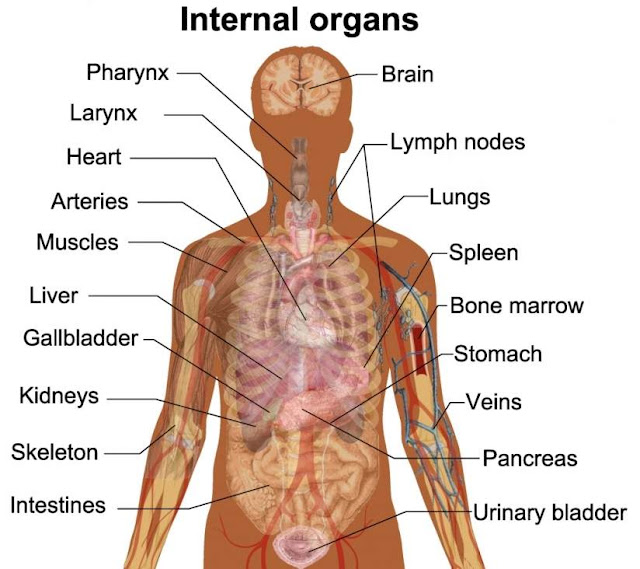The one you are going to read now would probably astound you as so far most of us thought that each and every organ in our body are useful for sustaining life. Of course, every one of us must have studied about vestigial organs during our schooling days that organs that have lost function during the course of evolution. Hence removal of these organs will not disturb the regular metabolic activities in your body. Here you will be knowing how the removal of the key organs like Stomach, Kidney, Speen, Gallbladder, Colon, Reproductive organs will allow you continue to live a normal subsistence.
When closely observed, Spleen has to two parts - dark red area and pockets of the white coloured area. The dark red portion is responsible for storing and recycling of red blood cells and the white portion stores white blood cells and blood platelets (have an immune-related function). When Spleen is removed, the alternative organ that plays in storing and recycling of red blood cells is liver and the immune function of the spleen is carried out by lymphoid tissue.
Removal of one or both is common when affected by cancer or any physical injury. Research says that removal of both the ovaries in the female does not affect the life expectancy. Interestingly, removal of both testes increases the life expectancy in males.
The gallbladder is present beneath the liver. The organ receives bile from liver and stores before it is released into the small intestine. Bile helps in the breakdown of fat into monoglycerides and fatty acids. When intestine recognises fat in the food, it sends a hormone to the gallbladder, causing it to contract and release bile into the small intestine. Excess cholesterol in the bile can aid in the development of stones in the gallbladder which blocks the movement of bile. In such cases, cholecystectomy is performed to remove the gallbladder.
There are several reasons why kidney gets damaged and needs removal. Damage due to alcohol and drugs are the foremost reasons for the damage. If both kidneys fail, the person is placed on dialysis.
Spleen:
The organ is present on the left side of the abdomen, under the ribs. During injuries, the most commonly removed organ is Spleen. As ribs are most vulnerable to injuries, the spleen sitting close to ribs gets damaged and leads to abdominal trauma. This may lead to death if not diagnosed and treated.
When closely observed, Spleen has to two parts - dark red area and pockets of the white coloured area. The dark red portion is responsible for storing and recycling of red blood cells and the white portion stores white blood cells and blood platelets (have an immune-related function). When Spleen is removed, the alternative organ that plays in storing and recycling of red blood cells is liver and the immune function of the spleen is carried out by lymphoid tissue.
Stomach:
Wondering how could you live without a stomach? Stomach performs four major functions - Mechanical digestion of food, Chemical digestion, absorption and secretion of the waste. Sometimes when affected by cancer or trauma, Stomach is removed. In this case, surgeons attach Oesophagus directly to the Small intestine. People can lead a normal life by having additional vitamin supplements.Reproductive organs:
The reproductive organ is male is Testis and Female is Ovary. These structures are paired and people can still have children by removal of one of the pairs.
Removal of one or both is common when affected by cancer or any physical injury. Research says that removal of both the ovaries in the female does not affect the life expectancy. Interestingly, removal of both testes increases the life expectancy in males.
Colon:
The primary function of Colon or Large Intestine is to reabsorb water and prepare faeces by compacting the matter. The large intestine is divided into cecum, colon, rectum, and anal canal. Colon is removed in people affected by cancer and most people recover well soon after the surgery. However, a soft diet is recommended for this people.Gallbladder:
The gallbladder is present beneath the liver. The organ receives bile from liver and stores before it is released into the small intestine. Bile helps in the breakdown of fat into monoglycerides and fatty acids. When intestine recognises fat in the food, it sends a hormone to the gallbladder, causing it to contract and release bile into the small intestine. Excess cholesterol in the bile can aid in the development of stones in the gallbladder which blocks the movement of bile. In such cases, cholecystectomy is performed to remove the gallbladder.
Kidneys:
It is a known fact that people have two kidneys and can survive with only one kidney. The primary function of the Kidney is to filter blood to maintain water and electrolyte balance. The Kidney acts as a sieve to filter the useless matter and hold onto the things like Proteins, Vitamins and minerals.There are several reasons why kidney gets damaged and needs removal. Damage due to alcohol and drugs are the foremost reasons for the damage. If both kidneys fail, the person is placed on dialysis.


No comments:
Post a Comment